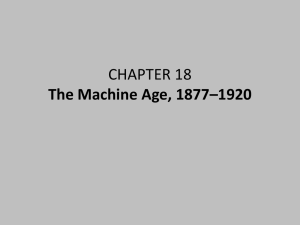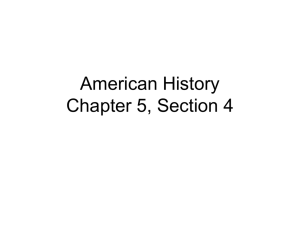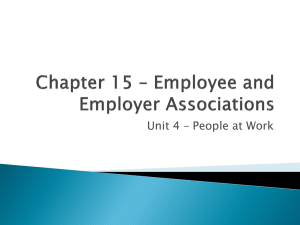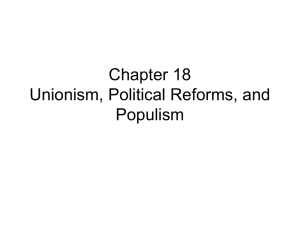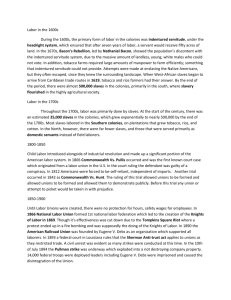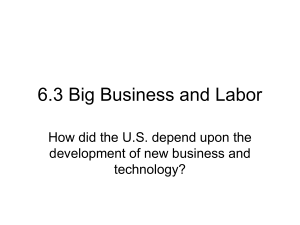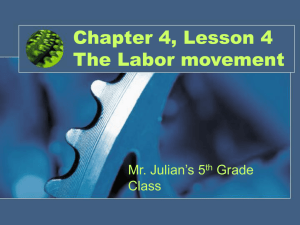5th Period - Labor and Unions
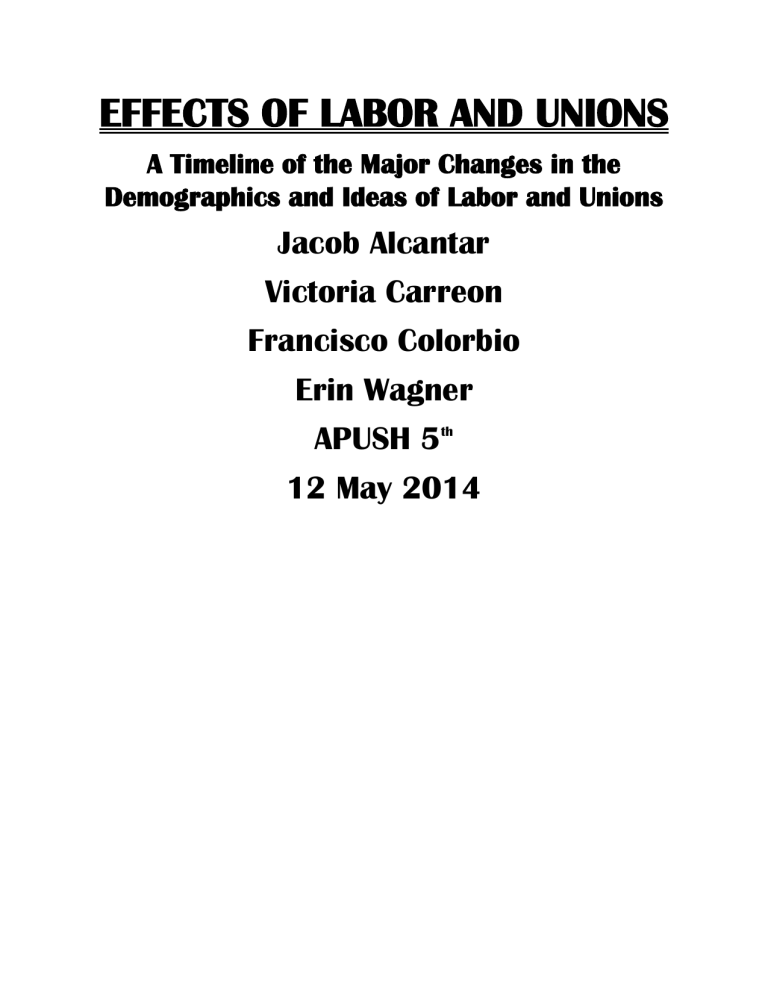
EFFECTS OF LABOR AND UNIONS
A Timeline of the Major Changes in the
Demographics and Ideas of Labor and Unions
Jacob Alcantar
Victoria Carreon
Francisco Colorbio
Erin Wagner
APUSH 5
th
12 May 2014
The 1600s
The discovery of the Americas by Christopher Columbus in 1492 led to the first needs of labor in the New World. Native Americans were enslaved to provide the work needed by the
Spanish who were the most powerful colonial power until the English took over. The colonial era of early North America began with the creation of multiple colonies; the most significant of these colonies was Jamestown , the first successful English colony. Jamestown was funded by a joint-stock company , a group of investors who bought the rights to establish New World plantations from the king. These investors expected a return of their expenses by a concept of mercantilism , the economic theory that trade generates wealth and is stimulated by the accumulation of profitable balances to create great wealth. The colonists faced hard times and had to come together as a community to survive. Labor during this time period was imperative to their survival. Captain John Smith decreed that “he who shall not work shall not eat” and attempted to pull the colonists together until he was injured in a gun powder explosion and had to sail back to England. After he left, the Powhatan Confederacy stopped supplying Jamestown with food. The winter of 1609-1610 became known as “ the starving time ” as 500 settlers perished, the survivors eventually found an English ship carrying supplies and new settlers. John
Rolfe married a Powhatan woman named Pocahontas and he pioneered the practice of growing tobacco , which would become a cash crop in Virginia. The role of tobacco in Virginia’s economy would result in rapid expansion and new settlements began to spring up which led to the creation and expansion of indentured servants , people who promised seven years of labor in return for free passage to the colonies. After these servants fulfilled their seven years of servitude they were allotted a small piece of property thus enabling them to survive and vote, however most usually died before achieving their freedom. This form of labor became the most effective way to gain passage to the Americas as 75% of the 130,000 Englishmen who migrated to the
Chesapeake were indentured servants. In 1618 the Virginia Company introduced the headright system as a means to attract new settlers to address the labor shortage created by the rapidly growing demand for tobacco. In 1619 Virginia established the House of Burgesses and in the same year the introduction of slavery to the English colonies would revolutionize labor until the
Civil War. The southern colonies thrived on an agricultural economy from tobacco that required many workers, many of which would be slaves. Slavery would not only shape the economy of the South, but the culture and the people there and would also be the reason the North and South would eventually go to war.
1700s
Following the era of colonization the beginning of the eighteenth century brought about a period of rapid growth. During the commencement of the 1700's the population within the colonies was roughly 250,000 individuals, and exponentially increased throughout the century.
With a majority of the colonists living in rural areas, labor was divided along gender lines.
Males spent their time performing outdoor duties such as farming, while women executed the indoor work of housekeeping and childbearing. Living in a patriarchal society women and children found themselves completely subordinate to men, particularly to the head male of the household. Additionally white working men were granted rights that women did not have access
to such as being able to vote, own property, or testify in court. With the growth of labor in the colonies the need for slaves increased as they were needed to speed up operations. During this time most Blacks lived predominantly in the countryside of the south. In the south labor was difficult as the climate was less hospitable to work. Slaves that worked on large plantations had developed specialized skills that fared better than field slaves. The conditions of servitude during this time was demeaning. Differently in the north black slaves often had tribulations maintaining a sense of community history. Slaves were mainly desired in the southern states since the agriculture was for fertile for work to be down. Additionally living conditions in the north were unsanitary, resulting in more workers and their slaves moving down to southern states where they would be in better living environments. Therefore by living in a better environment they were able to make more funds.Due to the labor boom of the 1700's Americans based their economy on Subsistence Agriculture. This is a form of self-sufficiency farming in which the farmers focus on growing enough food to feed themselves and their families. This includes families keeping crops and animals needed to feed and clothe themselves during the year.
Northern farmers produced a variety of crops and livestock, sometimes supplemented by craftwork; Southern plantation agriculture concentrated on crops. During the 1700s overseas trade was not as popular as colonists focused on maintaining all available goods for themselves.
Additionally this was a time where America had a non-monetary economy as all goods were traded or kept for personal use.
1800-1850
During the Industrial Revolution, which was in the 1800s, America had shifted from relying on agricultural based lifestyle to an urban based system which was reliant on wage labor.
The sudden burst in growth in the textile industry by the 1800s through the 1850s provoked a shortage of labor in the New England colonies. Textile manufacturers had to bring in labor force by providing conditions in which the workforce would find it acceptable. The
“Lowell System” invented by the 1830s, which guaranteed employees housing, chaperoned boarding houses; cash wages; and participation in cultural and social events organized by the mill. The system was beneficial until great waves of Irish immigration began to happen in the 1840s and 1850s made the labor plentiful but resulted in work conditions to start to deteriorate, this resulted in workers to organize labor unions to protect their interests of work, and these unions were not met with strong, violent opposition from industry.
1850-1900
The Age of Invention began as so many technical advancements began to dominate the mid 1800's. Labor unions rose to power with assembly line production , as employees were now required to work efficiently, and repetitively. Additionally these machines allowed for cheaper products as a result of selling more. This resulted in the concept of economies of scale . This new type of production required workers to perform a single task over and over, often for 12 to 14 hours a day. Factories also became dangerous due to machine malfunctions and human errors which resulted in more than 500,000 injuries per year to workers. Manufacturers cut costs and maximized profits by hiring women and children. Also manufacturers in the cities found
themselves hiring newly arrived immigrants in search of work. Since manufacturers paid as little as possible, the cities in which their employees lived suffered many problems such as poverty, crime, and disease. Factories proved to be a dangerous work environment as insurance and workmen's compensation did not exist. As factories expanded cities became dirtier and generally were less healthy environments. However the advances in mass transportation such as railroad lines, streetcars, and the construction of subways added to a growing middle class in cities. Unfortunately minority groups in America still lacked job opportunities such as Blacks and Latinos.
Still facing unfair working treatments misery filled the cities, and resulted in rising labor unions. Unions were considered radical organizations by many, and the government wary of them; businesses and the courts were openly hostile to the. One of the first national labor unions was the Knights of Labor founded in 1869 by Uriah Stephens , a Philadelphia tailor.
The Knights of Labor organized skilled and unskilled workers from a variety of crafts into a single union. With the goals (1) an eight-hour workday; (2) equal pay for equal work for men and women; (3) child labor laws, including the prohibition of working under the age of 14; (4) safety and sanitary codes; (5) a federal income tax; and (6) government ownership of railroad and telegraph lines. Although the Knights supported mediation over strikes, over time they became increasingly violent during their efforts to achieve their goals. The Knights of Labor continued its vast expanse under the leadership of Terence Powderly who helped to boost the support of the 8 hour work day and provoked the extreme influence of the Knights of Labor .
However his popularity greatly decreased after violence became a trademark symbol of the
Knights of Labor, which is often associated with the Haymarket Square Riot, a strike in which a bomb was set off killing police officers, this would lead people to associate the Knights of Labor with anarchists therefore lowering the union’s effectiveness. Another powerful and highly influential labor union was the American Federation of Labor headed by Samuel
Gompers, this union was widely popular because it focused mainly on the issues of workday length and higher wages rather than the larger political questions of labor, however the AFL refused to admit blacks, immigrants, and women as it became a confederation of trade unions
(composed exclusively of single trade workers). The South still relied on the revenue of agriculture and therefore required a new form of labor because plantation owners could no longer depend on the work of their slaves, so they resorted to sharecropping which employed poor farmers by granting them a small plot of farmland and farming tools in exchange for a share of the crops produced, hence the name, this was based on the crop lien system which was created to keep the poor in constant debt. These drastic changes in labor both in the North and South would immensely influence the coming five decades.
1900-1950
The gains that labor made during the latter half of the 19 th century spiked even further advances for the blue-collar workers of the 20 th
century as the Progressive Movement provoked labor victories on the state level (child labor laws, wage requirements, work day limitations) and also equally distributed income taxes to reallocate the nation’s wealth. Due to the amassed red scare of the 1920s radical labor unions were perceived to be the works of anarchists and communists and therefore were branded as enemies of the state, one of these unions was the
International Workers of the World which stressed the issue of immigrant and minority rights
furthering the nativism seen throughout the early 20 th
century. As the fear of the unions increased, federal troops eventually repressed unions arguing for higher wages and better working conditions in the steel, coal, and railroad industries. This rise in strike violence would lead to the Supreme Court overturning a minimum wage law that protected women and nullifying a child labor restriction. As the Roaring Twenties commenced, most of the prosperity of the era generated from big business and the chiefly Republican government that supported it.
Welfare Capitalism, the dissuasion of blue collar workers by their employers to join labor unions, also served effectively in the decline of labor union membership. After World War II two chief occurrences would define the pathway for Cold War and modern labor, first was the
United Mines Workers (UMW) Strike in 1948. The popularity of unions was at an all-time low as most Americans were conservatives so when coal miners cut off energy supply to other industries, causing the shutdown of steel companies and auto plants among others, for basic labor rights, most Americans were extremely aggravated provoking Truman to order a government seizure of the mines when an agreement could not be made. This strike would cause the legislature to pass the Taft-Hartley Act of 1948 which constrained labor’s right to strike, allowed government to intervene in strikes, and prohibited any union funding. The development of the labor movement in the early 20 th
century would provoke innovation in post-war and modern labor movement that still effect the labor movement today.
1950-Present
Through his last years in office Harry S. Truman tried to veto the Taft-Hartley Act , which prohibited “union only” work environments called “ closed shops ”, restricted labor’s right to strike, prohibited the use of union funds for political purposes, and gave the government broad power to intervene in strikes, but ultimately failed which weakened labor unions. With Truman leaving office in 1953, Dwight D. Eisenhower assumed control of the country. The 50’s were a time when consensus of values reigned, where everyone thought alike and anything foreign or different was rejected, and a time of consumerism was taking place. Under Eisenhower the government built the Interstate Highway System , which led to a boost in the economy (due to immense job creation) and the creation of the suburbs . The Cold War held the Soviet Union pitted against the United States in an Arms Race , to see which country held the more superior military power. This bitter rivalry inspired advances in technology and the creation of the
National Aeronautics and Space Administration (NASA) , which in turn created jobs and financial opportunities. The Kennedy administration is probably not known for any major labor changes but in 1963 Congress passed the Equal Pay Act , which called for men and women to receive equal pay for equal work. Lyndon B. Johnson oversaw the establishment of the Equal
Employment Opportunity Commission (EEOC) , to enforce the employment clauses of the
Civil Rights Act.
Nixon’s Presidency worsened the economy as the country went through a period of combined recession-inflation that economists called stagflation. He tried to mend the economy but only achieved a price-and-wage freeze and increased federal spending. Ronald
Reagan tried to revive the economy by applying the notion of supply-side economics . He thought that by cutting corporate taxes that they would earn greater profits which would “ trickle down
” and create jobs and reinvigorate the economy. Under Reagan’s policy the rich got richer and the poor get poorer. Tax cuts, increased military spending, and the failure of Reagan’s New
Federalism plan combined to escalate the federal budget deficit . Labor and labor unions evolved greatly since the discovery of the Americas.
List of Terms
1.
Jamestown- the first successful English colony.
2.
Joint-Stock Company- a group of investors who bought the right to establish New World plantations for the king.
3.
Mercantilismeconomic theory which states that trade generates wealth and is stimulated by the accumulation of profitable balances to create great wealth.
4.
Captain John Smith leader of Jamestown
5.
Powhatan Confederacygovernment of the Powhatan Indians
6.
Starving Timewinter of 1609-1610 in which 500 settlers died of starvation and disease
7.
John RolfeEnglish settler who would marry Native American
8.
Pocahontas daughter of Powhatan chief
9.
Tobaccomain cash crop of the century
10.
Cash Crop a crop produced with the intent to earn profit
11.
Indentured Servantspeople who exchanged seven years of labor for their paid passage to the colonies and would eventually gain their own plot for their service.
12.
Headright Systemused to attract settlers and increase the size of the labor force
13.
House of Burgesses the first elected legislative house in the New World
14.
Rural Areas - A geographic location located outside cities or towns.
15.
BlacksA racial classification or of ethnicity to describe persons who are defined as belonging to a "black" ethnicity in their particular country, typically having a degree of Sub-Saharan ancestry, or whom are perceived to be dark-skinned.
16.
Subsistence AgricultureA self-sufficiency farming in which the farmers focus on growing enough food to feed themselves and their families.
17.
Lowell System- guaranteed employees housing in respectable boarding houses, cash wages, and participation in cultural and social events organized by the mill.
18.
Age of Invention- era of innovation and invention in the industrial world
19.
Assembly Line Productionthe repetitive process by which workers manufacture products in a short amount of time
20.
Economies of Scalelower costs lead to lower prices which lead to more purchases which in turn leads to more profit.
21.
Immigrants A person who comes to live permanently in a foreign country.
22.
Latinos A term chiefly used in the United States to refer people of Latin American extraction or descent.
23.
Knights of Labor One of the first national labor unions in the United States.
24.
Uriah Stephens - A Philadelphia tailor responsible for founding the Knights of Labor.
25.
Terence Powderly- The leader of the Knights of Labor during its most violent stage
26.
Haymarket Square Riot the Knights of Labor under the leadership of Powderly bombed a square and killed police officers while striking for an 8 hour work day.
27.
American Federation of Labor a more popular union led by Samuel Gompers who chose to focus on basic issues, however minorities and women were not allotted membership into the union.
28.
Samuel Gompers founder of the AFL.
29.
Sharecropping poor farmers would tend land given to them by plantation owners who would gain a share of the crop for profit.
30.
Crop Lien System designed to keep the poor in debt
31.
International Workers of the World union designed to protect the rights of minority and migrant workers
32.
Welfare Capitalism the dissuasion of blue-collar workers by their employers to join labor unions.
33.
United Mines Workers Strike 1948 widely unpopular strike by coal miners for basic rights which provoked a decline in union membership.
34.
Seizure of Mines the government gained control of all coal mines in order to decrease strikes
35.
Taft Hartley Act of 1948 restricted labor’s right to strike, increased government ability to intervene in strikes, and forbade funding for unions.


